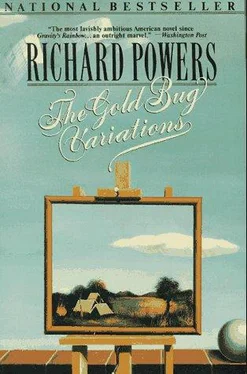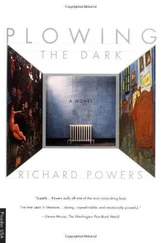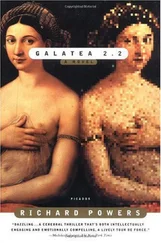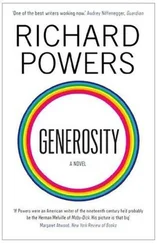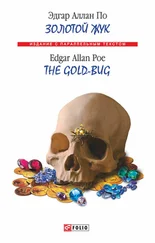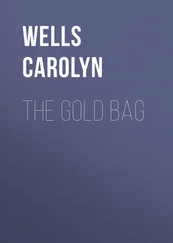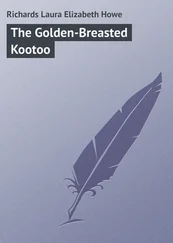Richard Powers - Gold Bug Variations
Здесь есть возможность читать онлайн «Richard Powers - Gold Bug Variations» весь текст электронной книги совершенно бесплатно (целиком полную версию без сокращений). В некоторых случаях можно слушать аудио, скачать через торрент в формате fb2 и присутствует краткое содержание. Год выпуска: 1991, Издательство: Harper Perennial, Жанр: Современная проза, на английском языке. Описание произведения, (предисловие) а так же отзывы посетителей доступны на портале библиотеки ЛибКат.
- Название:Gold Bug Variations
- Автор:
- Издательство:Harper Perennial
- Жанр:
- Год:1991
- ISBN:нет данных
- Рейтинг книги:5 / 5. Голосов: 1
-
Избранное:Добавить в избранное
- Отзывы:
-
Ваша оценка:
- 100
- 1
- 2
- 3
- 4
- 5
Gold Bug Variations: краткое содержание, описание и аннотация
Предлагаем к чтению аннотацию, описание, краткое содержание или предисловие (зависит от того, что написал сам автор книги «Gold Bug Variations»). Если вы не нашли необходимую информацию о книге — напишите в комментариях, мы постараемся отыскать её.
Gold Bug Variations — читать онлайн бесплатно полную книгу (весь текст) целиком
Ниже представлен текст книги, разбитый по страницам. Система сохранения места последней прочитанной страницы, позволяет с удобством читать онлайн бесплатно книгу «Gold Bug Variations», без необходимости каждый раз заново искать на чём Вы остановились. Поставьте закладку, и сможете в любой момент перейти на страницу, на которой закончили чтение.
Интервал:
Закладка:
Todd had a way of darting his eyes around as if the earth were the last thing he expected to see. I have forgotten that astonished tone, forgotten everything about him. He's back, wanted or not. But another sender here too, one I wouldn't know from a Dürer Adam. He is in trouble, needs me to write. As if a letter, even now, might serve as saving bedtime story.
The Question Board
Q: How often do questions appear here that you can't solve?
H.M., 8/11/81
A: More often than we'd like. According to a survey of American libraries, a third of questions to reference departments go unanswered. Ours weighs in a little under the national average, although we have no firm numbers.
J. O'D., 8/11/81
"What you need," Todd whispered into my ear, gazing over my shoulder as I typed, letting his hand loop dangerously over my ribs toward my breast, "is to copy the post office. A Dead Question Department." He lifted my hair and moistened the back of my neck. "Imagine: Question Purgatory. A smoky room full of three-by-fives, each unsolvable."
Putting One's Hands Through the Pane
Unbelievable: 1 can write him back at last. What I've ached to do for months, poring over atlases for clues, rehearsing the wording I'd use when given a place to reach him. Only now, I can't write the first clause. My block is worse than his: I can't even get off a salutation without seizing.
Another two readings and I still can't tell what's wrong. Indifference would feel simpler, would have no shakes. I've never written to him in my life. How can I start now, after everything? How could I begin telling him of my months reading a science I haven't any grounding in, depleting my savings, mourning the death he doesn't mention? I can't begin to concentrate on Dear Franklin until I've extricated myself from Dear Dr. Ressler. All I can do with his letter is add it to the evidence to be sifted. I can write only the same piece I've been working on for months. Why have we stayed apart all this time? Enzymes, friend.
I have only my work to answer him. The content of the coding problem compels me, twenty-five years after the facts. Discovery is a dependence that addiction only imitates. Engineered into my sequence, selected for obvious survival value, is a craving to lift the backdrop, to integrate the evidence, to mimic the tune so closely I can at last get through the notes. To force my hands through, touch the habitat. Assemble it. Ressler's was the desire behind all research: the pull of something simpler and stranger than imagined, lying within arm's length. Curiosity must, like every built-in desire, be written somewhere in the organism it wants to discover. Ressler looked for the fundamental lexicon in primitives. Only the results of the lookup table itself can explain why he was hooked on breaking it, on getting to the name of experimental desire.
Can anything as composite as curiosity be revealed by a set of equivalences, a molecular cipher wheel? Nothing in the chemistry of nucleic acid gives the first hint of the creature enclosing it. The sequence of base pairs in the molecule, their disorderly pattern, provides the edge needed to record a message. But the sequences themselves are not yet vernacular, but a shorthand. An arbitrary string CGAGGACCGACG, without a translator's dictionary, is gibberish. The lookup table supplies that dictionary; without semantic meaning itself, it lends the first suggestion of sense to unreadable data.
The translation Ressler worked on is a one-for-one, simple substitution. My arbitrary string, pressed through the table, maps to a single protein: arginine-glycine-proline-threonine___Transliteration to aminos alone seems to move me no nearer the evolution of heart, chest, hands, eyes — those devices against the caprice of environment. Slavish substitution appears no more helpful in finishing my triple bridge than those primitive DOD translators Ressler once tapped us into. One night, taking us on a tour through the vast MOL on-line network, he tapped into a machine translation program. He selected "French" for target language and typed in the string "I am left behind." We shouldn't have been playing with the restricted program at all, but that didn't keep Todd and me from hanging on his every keystroke. The algorithm churned away on a mighty effort of pattern matching and produced "Je suis gauche derrière." He hooked up two of these software Berlitz's back to back, feeding English-to-French back into its reciprocal. "Out of sight, out of mind" returned to source language as "blind lunatic."
All I've done with codon translation is rename the elements I started with. ACG becomes threonine; I've just swapped chemical terms. And yet, the map is never quite the place, nor the place as navigable as its image. It has taken me months to see that the coding problem is just the start of the cryptography. If that were the extent of inheritance, the lookup table would produce only tautological definitions. The hundreds of base pairs in a gene, broken into triplet codons and fed through the decoder, would produce the telegram "Please refer to original dots and dashes."
All these ciphers mean nothing until I find the difference created in translation. The table only softens the inscrutable script, shapes the clay into executable words. Cracking the code is just the tip of the Goldberg. The lookup list of simple equivalences requires me to learn how to interpret, implement the text that comes out of it. For data to grow, respond, rise up and walk I must look at the secondary structures locked in the life molecule. I want a deeper definition from the string — its isomorphs of hope, ache, posted desire.
The bouillabaisse is richer than I've guessed. The punched tape running along the inner seam of the helix is much more than a repository of enzyme stencils. It packs itself with regulators, suppressors, promoters, case-statements, if-thens. Genes coding for messengers, readers, and decoders of genes. Genes to copy and build the genes' copiers and builders. Genes that may speed, slow, or reverse their own mutation. The automated factory imbeds a blueprint for its own translation machinery — a glimpse of real invention that knocks me for a loop.
How, from simple substitution, can this absurd surplus emerge? A gene and its enzyme, while code-equivalent, are worlds apart in function. The decoded string contains more than its original. My mistake has been in thinking of enzymes as simple ropes of twenty-colored beads. Even though this model provides more necklaces than the most scrupulous socialite could wear in an eternity of nights out, my metaphor misses a key point. Each color pattern corresponds to a specific necklace twist. And shape, in stereochemistry, is behavior by another name.
Protein necklaces are actually closer to wildly tangled wool fuzz. They are strings, but coiled as erratically as Norwegian hair run through a home permanent. (Wool, hair — two prime analogies.) Only, the twists that the fiber balls up into are rigid, fixed by the sequence of the aminos. I feel my first spark: the growing poly-peptide — arginine, glycine, proline — folds up in a manner determined by the amino sequence coded for in the synthesizing gene. The resulting three-dimensional globule carries spatial information; a landscape of grottos, peaks, and plains gives the enzyme catalytic ability — the power to bring about reactions that otherwise might not have taken place.
Even if the strand is stretched, it will spontaneously reform to the coiled arrangement unique to its linear sequence. This complex but ordained shape turns the enzyme into a cookie cutter, machine tool, a shoehorn introducing big foot into recalcitrant slipper. Smaller molecules align with spots on the enzyme landscape where they precisely fit. Held in place, they are brought together to react with another similar squatter. Each uniquely shaped enzyme is expert at bringing about a particular reaction. The human genome codes for countless enzymes, each a chemical command, a potential engine capable of producing a specific chemical event.
Читать дальшеИнтервал:
Закладка:
Похожие книги на «Gold Bug Variations»
Представляем Вашему вниманию похожие книги на «Gold Bug Variations» списком для выбора. Мы отобрали схожую по названию и смыслу литературу в надежде предоставить читателям больше вариантов отыскать новые, интересные, ещё непрочитанные произведения.
Обсуждение, отзывы о книге «Gold Bug Variations» и просто собственные мнения читателей. Оставьте ваши комментарии, напишите, что Вы думаете о произведении, его смысле или главных героях. Укажите что конкретно понравилось, а что нет, и почему Вы так считаете.
